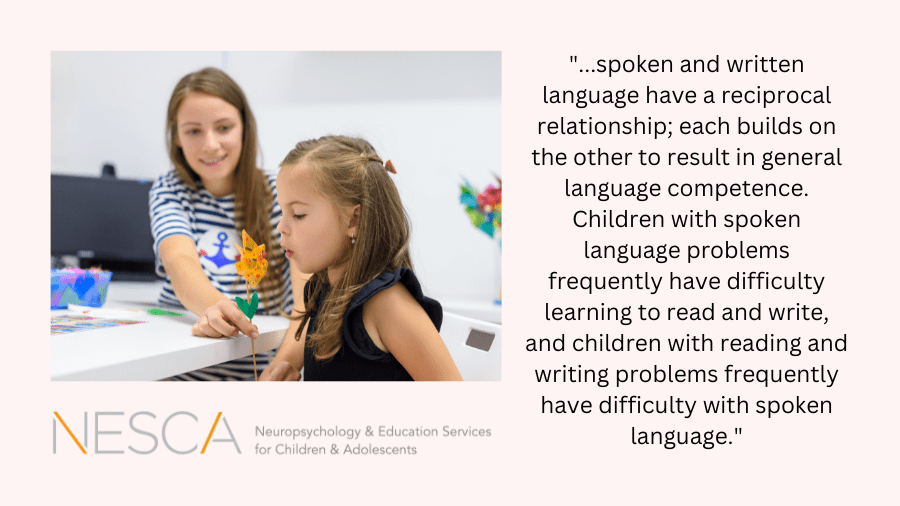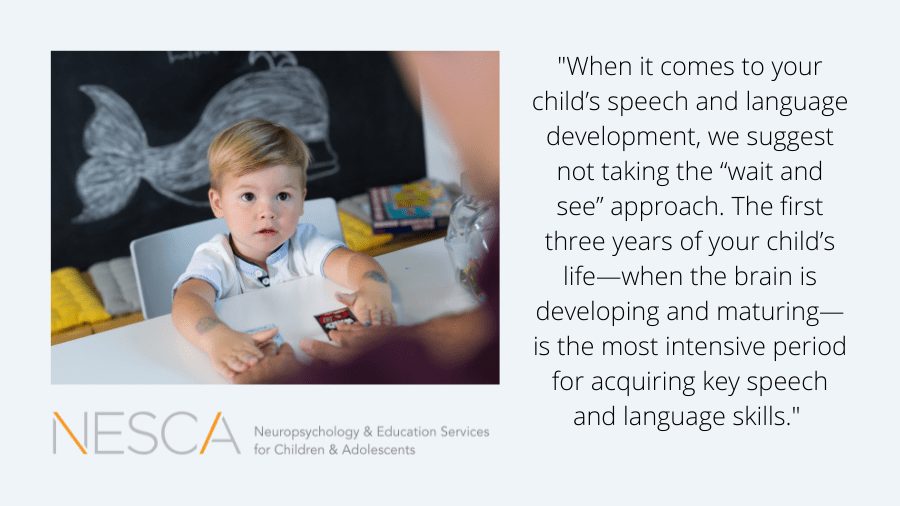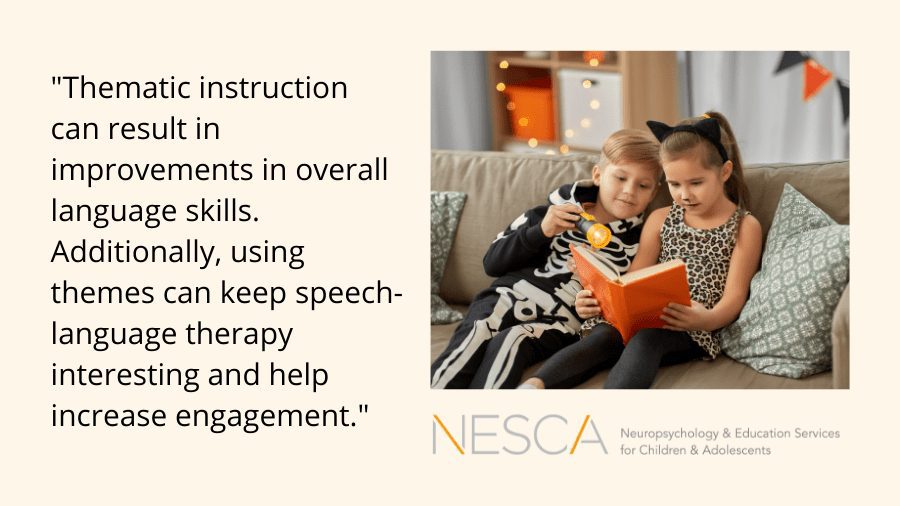
 By Olivia Rogers, MA., CCC- SLP
By Olivia Rogers, MA., CCC- SLP
Speech-Language Pathologist, NESCA
A written language disorder is an impairment in fluent word reading (i.e., reading decoding and sight word recognition), reading comprehension, written spelling, and/or written expression (Ehri, 2000; Gough & Tunmer, 1986; Kamhi & Catts, 2012; Tunmer & Chapman, 2007, 2012). As written language disorders are quite complex, appropriate assessment and treatment often incorporates many members. Members of the interprofessional practice team may include, but are not limited to, reading specialists, occupational therapists, special educators, learning specialists, and more.
When you think of a speech-language pathologist (SLP), a few words probably come to mind; terms like articulation, language, or fluency. Often, SLPs are associated with spoken language only. Most people don’t think of reading or writing when they think of SLPs. However, in addition to the diagnosis and treatment of spoken language disorders, it is well within the scope of practice of a SLP to diagnose and treat written language disorders. In fact, spoken and written language have a reciprocal relationship; each builds on the other to result in general language competence. Children with spoken language problems frequently have difficulty learning to read and write, and children with reading and writing problems frequently have difficulty with spoken language. Children with speech and language deficits are at a higher risk for reading and writing difficulties. Higher rates of all forms of written language disorders have been documented in children with speech and/or language impairments. Take a look at these findings:
- Comorbidity between literacy difficulties and speech and language deficits occurred in as high as 50% of cases (Stoeckel et al. (2013).
- By the end of kindergarten, more than 25% of children with language impairment were reported to also be poor readers (Murphy et al., 2016).
- Approximately 20%-28% of children with speech sound disorders (SSD) have literacy difficulties (Overby, Trainin, Smit, Bernthal, and Nelson, 2012).
No matter the age, SLPs can assess and treat spoken and written language difficulties. SLPs bring knowledge of communication processes and disorders, and language acquisition to the literacy table. Additionally, SLPs are skilled in dynamic assessment and have clinical experience in developing individualized programs for children and adolescents. Here are just a few written language skills that SLPs work on:
Reading: Pre-reading Skills
Before a child can decode, or read, they must have an understanding that words are composed of smaller units and how these units operate separately and together. SLPs incorporate the following skills into sessions:
- Rhyming (e.g., “flag and stag”)
- Syllable segmenting (e.g., “student: stu/dent”)
- Blending sounds into words (e.g., “sh/i/p says ‘ship’”)
- Segmenting words into their sounds (e.g., “leg: l/e/g”)
- Deleting sounds in words (e.g., “cup without the c is up”)
- Substituting sounds in words (e.g., “change the ‘B’ in bat to an ‘M’”)
Reading: Language Comprehension
This is the biggest one for SLPs. To target language comprehension, we work on smaller goals, such as:
- Grammar
- Story Grammar Elements
- Visualizing and Verbalizing
- Vocabulary
- Active Reading Strategies
- Themes
Writing: Organization/Planning
Before writing, it is important to plan out what you will write. Many children with language disorders have trouble with these skills. Here are just a few ways that SLPs help children plan and develop their writing by:
- Using visuals for story grammar components
- Make and practice using graphic organizers
- Teaching sentence, paragraph, and essay construction
Spelling
Yes, spelling! SLPs are equipped to work on spelling. After all, it is just another language skill. Some ways to target spelling include:
- Working on phonological awareness and phonemic awareness
- Teach students about morphology (the study of words and their parts)
- Incorporation of working memory strategies, such as chunking, visualization, or mnemonics
If you have concerns about your child’s pre-literacy or literacy skills, or would like to support your child’s written language skills, please contact NESCA’s Olivia Rogers at orogers@nesca-newton.com or fill out our Intake Form, noting an interest in speech language pathology.
Sources:
Overby, Trainin, Smit, Bernthal, and Nelson, 2012) Preliteracy Speech Sound Production Skill and Later Literacy Outcomes: A Study Using the Templin Archive.
American Speech-Language-Hearing Association. (2001). Roles and responsibilities of speech-language pathologists with respect to reading and writing in children and adolescents [Position Statement]. Available from www.asha.org/policy.
Catts, H.W. & Weismer, S.E. (2006). Language Deficits in Poor Comprehenders: A Case for the Simple View of Reading. Journal of Speech, Language, and Hearing Research, 49, 278-293.
About the Author

Olivia Rogers received her Master of Arts in Speech-Language Pathology from the University of Maine, after graduating with a Bachelor of Arts in Communication Sciences and Disorders and concentrations in Childhood Development and Disability Studies.
Ms. Rogers has experience working both in the pediatric clinic setting as well as in public schools, evaluating and treating children 2-18 years of age presenting with a wide range of diagnoses (e.g., language delays and disorders, speech sound disorders, childhood apraxia of speech, autism spectrum disorder, social communication disorder, and Down syndrome). Ms. Rogers enjoys making sure therapy is fun and tailored to each client’s interests.
In her free time, she enjoys listening to podcasts and spending times with friends and families.
Neuropsychology & Education Services for Children & Adolescents (NESCA) is a pediatric neuropsychology practice and integrative treatment center with offices in Newton, Massachusetts, Plainville, Massachusetts, and Londonderry, New Hampshire, serving clients from preschool through young adulthood and their families. For more information, please email info@nesca-newton.com or call 617-658-9800.
To book an appointment with Olivia Rogers, please complete our Intake Form today. For more information about NESCA, please email info@nesca-newton.com or call 617-658-9800.






Connect with Us